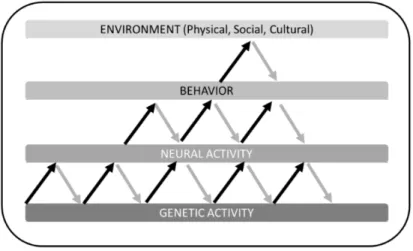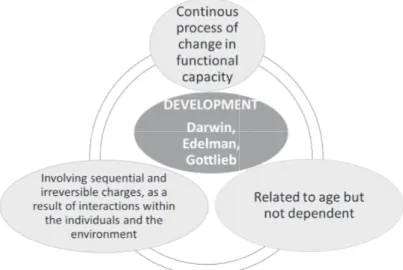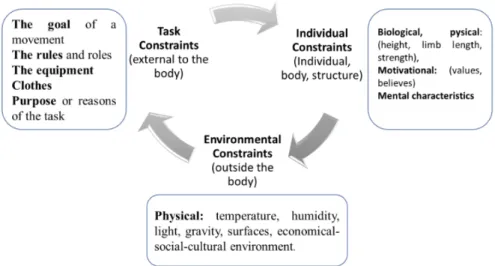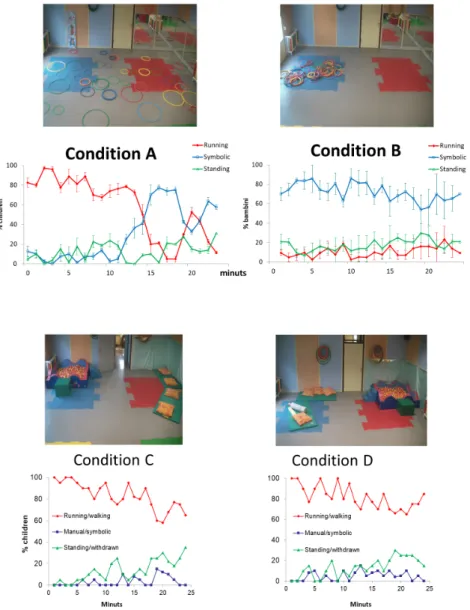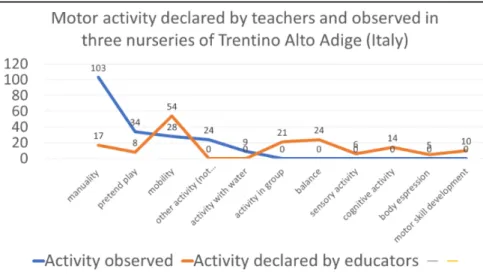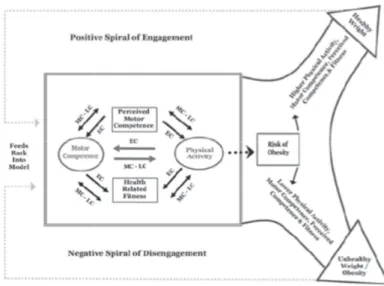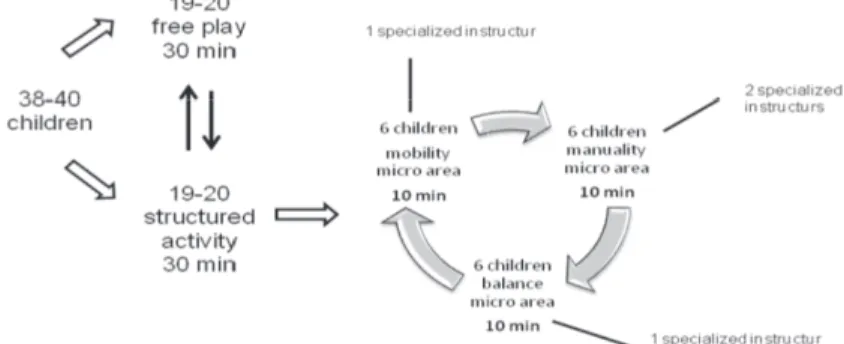Ambienti e contesti per progettare l’educazione
motoria in età prescolare
Environment and contexts to plan
motor education in preschoolers
ABSTRACT
For experts and specialists working with children is important to have knowledge about developmental theories to better understand what happens with processes as-sociated with motor behavior and child motor and general development. We can de-scribe development, according to Darwin, Edelman and Gottlieb as: a) continuous process of change in functional capacity; b) related to age (but not dependent); c) in-volving sequential and irreversible changes, result of interactions within the individu-als and between the individual and the environment. Newell (1986) emphasizes the in-fluence of experience (task) in motor development and highlights the dynamical, con-stantly changing interaction between them. There are factors that can limit, discourage or encourages motor activity called by Newell, constraints. The relationship between the organism and the environment offers affordances, that can be useful to a person, related to his/her capacities. When a child exploring and playing experiences new mo-tor skills and acquire them he discovers new affordances. In the article are reported some studies showing examples of affordances and a research realized in the play-ground “Primo Sport 0246” that highlight the affordances in a specific tool “Monkey Bars”. It is fundamental for educators to consider all the aspects related to a move-ment, as the organization of spaces, of materials and their characteristics are determi-nant in promoting affordances and motor development.
Per esperti e specialisti delle attività motorie nell’infanzia è importante la conoscenza delle teorie di fondo per comprendere i processi, il comportamento motorio, lo sviluppo motorio e generale. Possiamo descrivere lo sviluppo facendo riferimento alle teorie di Darwin, Edelman e Gottlieb, come: a) continuo processo di cambiamento di capacità, b) in relazione all’età e non dipendente da essa, c) che promuove cambia-menti irreversibili, come risultato dell’interazione tra individuo e gli altri e tra individ-uo e ambiente. Newell (1986) enfatizza l’importanza dell’esperienza (compito) nello sviluppo motorio e mette in risalto la costante interazione esistente tra essi. Ci sono fattori che possono limitare o incoraggiare l’attività motoria, chiamati da Newell “vin-coli”. La relazione tra organism e ambiente produce affordances, che possono essere utili alla persona in relazione alle proprie capacità. Quando un bambino esplorando e giocando sperimenta nuove competenze motorie e le acquisisce scopre nuove affor-dances. Nell’articolo sono riportati alcuni studi che mostrano esempi di affordances e una ricerca realizzata nel parco giochi “Primo Sport 0246” che mette in evidenza le af-fordances in uno specific gioco “Monkey Bars – Brachiazioni”. È fondamentale per gli educatori considerare tutti gli aspetti relativi al movimento, pochè l’organizzazione di spazi e materiali e le loro caratteristiche sono determinanti nella promozione delle af-fordances e nello sviluppo motorio.
KEYWORDS
Affordances, sviluppo motorio, età prescolare, educazione motoria, parco giochi. Affordances, motor development, preschoolers, motor education, playground.
Patrizia Tortella
University of Verona – Center for Research on Child Motor Development. [email protected] Fo rm a z io n e & I n se g n a m e n to X V I – 1 – 2 0 1 8 IS S N 1 9 7 3 -4 7 7 8 p ri n t – 2 2 7 9 -7 5 0 5 o n l in e S u p p le m e n to
Introduction – Theretichal Perspective on Motor Development
For experts and specialists working with children is important to have knowledge about developmental theories to better understand what happens with process-es associated with motor behavior and to better understand child motor and general development (Franchak & Adolph, 2014). Motor development is now at-tractive due to its association with cognitive, social and emotional domains of de-velopment.
What are the roles of genetic endowment, physical maturation and experi-ence in child motor development?
Philosophers in Greek times and later Descartes (1596-1650) believed that cer-tain ideas are innate while Locke (1632-1704) argued that a newborn’s mind is a blank slate (tabula rasa). Today it is clear that nature and nurture are inextricably intertwined. From biological point of view the Darwinian evolutionary theory in-troduced the notion on time as inherent factor and the notion of phylogenetic change. Darwin intended the evolution as a mechanism of accidental selection of variations by environment. The principle of the selection are the variations. Later Mendel introduced the explanation of the growth of the organism consid-ered as the result of instructions contained in the genes.
In 1987 Gereald Edelman in his book Neural Darwinism – The Theory of Neu-ronal Group Selection argued that human body is capable to create complex adap-tive systems. His theory of neuronal group selection (Edelman, 1978) was based on three basic points: a) developmental selection: every person has a different synap-tic structure due to the functional plassynap-ticity of the neuronal groups, self-organized in “modules”; b) Experiential selection: within the neuronal groups the experi-ences determine a process of synaptic selection. Dependently on the experience the neurons involved can be strengthen or weaken; c) Reentrant signaling: spon-taneous groups of neurons are forming re-entrant connections.
Fig 1. The basis of the Theory of Neuronal Group Selection
Adapted from Edelman, 1993, p. 116, figure n. 1
Sporns and Edelman (1993) argue that the process of skill learning is specific and this means that if somebody wants to develop a specific task he/she needs to train it in the way to strength the synapses involved in that task. Training facilitates the opportunity to make more probable to execute the same behavior next time. When the organism interacts with the environment each pair of neurons uti-lized correlates well and these connections will be strengthened thanks to exer-cise and repetition. The inefficient connections will be very little correlated and their connections will become weakened and sometimes completely nonfunc-tional by time. (Adams, 1998). The groups of neural connections persist through selection without influences by genes or the environment. The experience is fundamental in neural connections.
! ! ! ! ! ! ! ! ! ! ! ! ! ! ! ! ! ! ! ! ! ! ! ! ! ! ! ! ! ! "#$#%&'(#! )&*#+,&-#+'+,!.*! /#01#+'+,!.2! )3+04)#)!0)!*#)5$&! .2!6#-0('.*7! !
P
a
tr
iz
ia
T
o
rt
e
ll
a
In motor control a movement results from the contribution of multiple pop-ulation of neurons, each involved in a specific direction of movement (Geor-gopoulos et al., 1986). A specific movement is the result of the activation of an ap-propriate combination of neuronal groups. The choice of the apap-propriate move-ment, between multiple degrees of freedom of the joints is made in a selection of appropriate movements from a repertoire of variants, resulting from the un-derlying neuronal group selection (Sporns and Edelman, 1993). Maennistoe et al. (2006) demonstrated that a special targeted skill training in children with motor learning difficulty improved consistently their targeted skills, compared with children trained in general skills. The specificity of the learning is also demon-strated by research of Revie et al. (1993). The synapses not stimulated by experi-ence are subject to pruning. Children are living in an environment where they have some experiences at about the same time, that influences the pruning. The different experiences and the nature of brain activity determine which synapses survive. (Miller, 2011).
Gottlieb argues on the probabilistic epigenesis, not just genetic (Gottlieb & Halpern, 2002) of development that there are bidirectional influences within and between levels of analysis (2007, p. 1). So, the phenotypic variation is not strictly limited to random genetic mutation, drift and recombination, (Gottlieb, 2007. P. 9) but is the result of a lot of epigenetic processes that contribute to individual on-togeny. The environment (experience) selects which genes to activate (18)
Fig. 2 The figure illustrates the bidirectional influences between environment, behavior, neural activity and genetic activity in Gottlieb perspective (2007)
Summarizing, we can describe development, according to Darwin, Edelman and Gottlieb as: a) as a continuous process of change in functional capacity; b) related to age (but not dependent); c) involving sequential and irreversible changes, as result of interactions within the individuals and between the
individ-ual and the environment (Haywood et al., 2009).
A
m
b
ie
n
ti
e
c
o
n
te
st
i
p
e
r
p
ro
g
e
tt
a
re
l
’e
d
u
c
a
z
io
n
e
m
o
to
ri
a
i
n
e
tà
p
re
sc
o
la
re
Fig. 3 Development according to Darwing, Edelman and Gottlieb
1.1 Is motor development a general, universal developmental process?
Adolph highlights (2015) that since 1980 there were only few studies (5,2% of 5.617 journal articles) on motor development, compared with cognition, social, language, emotion, personality.
Studies on the mind that played attention on the inner processes (Piaget 1952, Vygotsky, 2013) determined the cognitive revolution. Researchers in cognition often consider the development related to chronological age and the passage of time is considered the factor responsible for developmental changes (Adolph & Berger, 2006; Adolph et al. 2012; Siegler, 2006).
Some researchers now (Adolph, 2015) instead of motor development prefer to use the words perceptual-motor development, perception and action, motor skill acquisition. Adolph (2015) argues that this highlights the relation between adaptive control of motor actions and psychological processes such us percep-tion, planning, decision making, memory, motivations.
The most popular perspective used by researchers in motor development, to-day, is the ecological perspective, that emphasizes the interrelationship between the individual, the environment and the task. For them the emergence of a mo-tor skill is dependent on the interrelation of body, environment and all internal and external constraints. This perspective considers constraints existing within the body, such as cardiovascular, muscular.
1.2 The constraints that influence the development
Newell (1986) emphasizes the influence of experience (task) and environment (Haywood et al., 2011) in motor development and highlights the dynamical, con-stantly changing interaction between them. There are factors that can limit, dis-courage or endis-courages motor activity called by Newell, constraints (Haywood et al., 2009).
P
a
tr
iz
ia
T
o
rt
e
ll
a
The researcher suggests that motor development is due to the interactions of the organism with the environment and the task. When one of these factors changes e movement and motor development change.
Fig. 4 Constraints of motor development of Newell’s model. The model shows different factor affecting and individual’s movement.
An example of Newell’s Model is the development of the overarm throw. Sev-eral children master this skill before 12 years old of age, but there are large indi-vidual variations in the mastery of the skill. We can observe difficulty with the tech-nique (high arm) or in direction and speed (outcome)(Sigmundsson et al., 2017).
1.3 Affordances
Eleonor Gibson posed at the basis of her perspective the affordances, a term in-troduced by James Gibson (1979). The affordance is an opportunity for action, what the environment offers or provide for an organism. Some surfaces afford walking or crawling, and the social environment offer affordances as smiling and angry. The relationship between the organism and the environment offers affor-dances, that can be useful to a person, related to his/her capacities. When a child exploring and playing experiences new motor skills and acquire them he discov-ers new affordances. Everybody has own ability to use potential affordances de-pending on the experience (Gibson & Pick, 2000).
The relation between bodily capabilities and physical properties of the envi-ronment exists objectively in the interface between self and world. The affor-dances become real regardless of whether they are perceived or used. They re-flect both environment and perception-action reciprocity, because they need to be perceived. The perception must guide the action and actions are implicit in the affordances.
For Gibson (1982) ““we do not perceive stimuli or retinal images or sensations or even just things; what we perceive are things that we can eat, or sit down on, or talk to” (p. 60). We perceive the functional relation between self and the world.
A
m
b
ie
n
ti
e
c
o
n
te
st
i
p
e
r
p
ro
g
e
tt
a
re
l
’e
d
u
c
a
z
io
n
e
m
o
to
ri
a
i
n
e
tà
p
re
sc
o
la
re
For example, we don’t perceive the size or distance of objects, but whether they are within arms’ reach and whether the object will fit into our grasp.
As action capabilities change we become more able to detect appropriate supports ad resources to discover new affordances.
Learning new motor skills allows a child to acquire new possibilities for ac-tions, to develop new affordances, to be able to better master his actions in the world and to increase the process of “learning how to learn” (Adolph, 2008).
Infants, toddlers and children live in an environment and in a social context and depend on the caregivers rearing. Cross cultural studies suggest that differ-ent caregivers’ behavior might influence a differdiffer-ent developmdiffer-ent (Yen-Tzu, et al., 2008; Kolling, 2014).
Several studies show that prone sleepers acquire motor milestones earlier than supine sleepers (Jantz, 1997; Yen Tzu et al., 2008). In the various cultural groups people share ideas of adequate parenting practice based on parental be-lieves that lead to developmental consequences.
1.4 The role of context and environment in motor development
It is important to promote opportunities of movement and physical activities in nurseries and kindergarten, to provide motor development. The organization of the environment is an important constraint that can promote motor skills devel-opment and affordances. How teachers and educator organize the environment and plan the activity reflects their beliefs. To provide the widest range of effica-cious activities for children and to provide their development is important to consider what kindergarten teachers tell about their practices on motor educa-tion and what they really do.
A study on the importance of the environment (Tortella, Tessaro, Fumagalli, 2011) was conducted in a kindergarten, with 53 children of 3 years old. Four groups of children were organized and left without instruction (unstructured ac-tivity, free play) in a playroom where all furniture were removed for thirty min-utes in four different conditions. Condition A: circles of 50 cm of diameter were spread on the floor; condition B: the same circles were piled in one corner of the room; condition c) a pool with soft balls was placed in the center of the room; condition d) the pool was placed in one corner. Each group was wideo recorded and was measurd time spent in the different forms of activities and activity level (by pedometer).
The results highlighted that were children were in condizion A spent most of the time running o jumping in the circles (mobility activity) ; in condition B the most of the time was spent using circles for individual and/or pretend play and running/jumping was limited and random (object controll activity). In condition C and D no differences were observed and the children jumped in the pool all the time in both conditions (mobility activity). Data of accelerometer highlighted that children in condition A executed a number of steps significantly higher than the other groups. In all conditions the children imitated each other. Only in con-dition B children played in little group or with a friend. No differences were ob-served between boys and girls. The organization of space/environment had sig-nificant impact on children motor behavior and the spatial, different distribution of the tools in the space determined the type of their use in terms of motor ar-eas involved (object control skill, mobility).
P
a
tr
iz
ia
T
o
rt
e
ll
a
Fig. 5 Condition A: children spent most of the time running o jumping in the circles (mobility activity), Condition B: the most of the time was spent using circles for individual and/or pretend play and running/jumping was limited and random (object controll activity), Condition C-D: no differences were observed and the children jumped in the pool all the time in both conditions (mobility activity) Tortella, P., Bortolameazzi, F., Fumagalli, G. (2010
In the study (Tortella, Callegari, Tessaro and Fumagalli, 2012) the goal was to investigate on the practice of motor education of children beteween 18 months and 3 years old in 156 children of 46 municipalities in 6 nurseries of Trentino Al-to Adige. Twenty educaAl-tors of the nurveries was asked Al-to answer Al-to interviews regarding the organisation of daily activity and in the same time they were ob-served during three days. The results highlighted that what was declared by the ! ! ! ! !
A
m
b
ie
n
ti
e
c
o
n
te
st
i
p
e
r
p
ro
g
e
tt
a
re
l
’e
d
u
c
a
z
io
n
e
m
o
to
ri
a
i
n
e
tà
p
re
sc
o
la
re
educators was not corresponing with the activity children really did. It emerged that the children spent most of their time in manuality activity (manual dexterity) while educators declared in mobility activity.Children were very sedentary. It emerged that the educator were not aware of the activity they were doing with the children.
Fig. 6 – Results of motor activity declared by teachers and observation of the activity.
(Tortella, P., Callegari, L., Tessaro, F., Fumagalli, G. (2011)
2. Motivation
Following the Edelman Theory significant evidence are supporting the notion of the specificity of learning. Stöckel, T.; Hughes, C.M.L , 2015 and Giboin, L.S.; Gru-ber, M.; Kramer, A (2015) demonstrate low correlation between similar motor task and Drowatzky and Zuccato (1967) highlighted a very low correlations in balance tasks: a person can be good in one balance task but not in another one, as con-fermed olso by Haga, Pedersen and Sigmundsson (2008).
From the perspective of probabilistic epigenesis it is important to provide children with opportunities to quantitative and qualitative changes in motor de-velopment in a variety of context, accompanied by purposeful motor experi-ences in a variety of context and environments. The educators need to be re-sponsible in the promotion of learning enviroments for children.
As with new motor skills a child acquires new (affordances) possibilities for actions (Adolph, 2008) it is fundamental to provide children the most number of possibilities to increase motor skills. Increasing motor skills contribute to in-crease motor competence, that is fundamental to promote physical and mental health, as illustrated in the model of Stodden et al. (2008).
P
a
tr
iz
ia
T
o
rt
e
ll
a
Fig. 7 Stodden model of Developmental mechanisms influencing physical activity trajectories of children (Stodden et al., 2008)
3. Question of research
Can a playground provide the affordances to develop motor skills?
4. Method
To provide motor skill development and new affordances it was projected the playground “Primo Sport 0246” in Treviso (Tortella et al., 2016). The space (around 2500 mq) was organized in areas (Gallahue, 1982): manuality, balance and mobility.
Fig. 8 Playground “Primo Sport 0246” in Treviso (Italy)
A
m
b
ie
n
ti
e
c
o
n
te
st
i
p
e
r
p
ro
g
e
tt
a
re
l
’e
d
u
c
a
z
io
n
e
m
o
to
ri
a
i
n
e
tà
p
re
sc
o
la
re
The society Verde Sport (Benetton Group) from Treviso, owner of the play-ground, asked to use normal tools, selected from the catalog of a company. The tools were located in areas of functional use: for example tools for manuality ac-tivity are all concentrated in the manuality area and from the simple one to the very difficult one.
Are the tools positioned in the right place? Are they providing affordances of manuality, mobility and balance in children?
We observed the children for 2 years, from February to June, using videocam-eras in the various tools and tested the children before and after a training of 10 lessons organized in 30 minute of structured activity + 30 minutes of free play.
Fig. 9 Model of activity in the areas of the playground “Primo Sport 0246” (Tortella et al., 2016)
One tool of the manuality area was the “Monkey Bars”. Children had to walked with the hand, hanging on the bars. The tool was 2,30 m high and on the catalog it was recommended for children up to 2 years old.
Fig. 10 “Monkey bars” – Manuality area
4.1 Activity in the area of “Manuality”
The children have to walk with the hands hanging on the monkey bars, for 30 sec-onds, three, four time in 10 minute.
!
!
!
P
a
tr
iz
ia
T
o
rt
e
ll
a
During the activity on Monkey Bars childre was ask to walk on the hands as many as possible bars they were able to do.
4.2 Activity during free play
Children have 20 minutes of free time when they can have free play.
TOTAL number of children of 5 years old: 370 2010-11: n. children 38
2012-2014 experimental group n. children 152 2012-2014 free play group n. 74
2012.2014 control group (never came to the playground for training, only for test) n. 106
5. Results
The first year of activity (2019-11) the tool was 2,30 m high and the distance from the feet of the children to the floor was around 80-100 cm. We observed that the children did not executed more than 1 bar both in the pre and in the post test and they were not motivated to play on this tool during free play.
After 6 weeks of activity we put under the bars a matrasse 20 cm high, to re-duce the distance between the feet of the children and the floor, as we supposed that the jump was to high for the children. The distance to the floor, with the ma-trasse, was around 15-20 cm. We did not observed any change after this. The chil-dren appearto be not motivated to play on this tool both before and after put-ting the matrasse.
In the next years (2012-2014) we decided to reduce the high of the tool and cutted it. The toll is now 1,65 m high. The children can hanging with a distance of their feet to the floor of 10-20 cm cm (mean).
The results were better than the previous year, both in pre and in post test, for experimental, free play and control groups, as is possible to see in the follow-ing table
Table 1 Results in the test of Monkey bars.
A
m
b
ie
n
ti
e
c
o
n
te
st
i
p
e
r
p
ro
g
e
tt
a
re
l
’e
d
u
c
a
z
io
n
e
m
o
to
ri
a
i
n
e
tà
p
re
sc
o
la
re
Conclusion
The first year (2010-11) the activity at the Monkey Bars did not improved after put-ting a matrasse under the tool, to reduce the distance of the feet of the children to the floor from around 100 cm to around 20 cm.
The years (2012-2013-2014) after reducing the high of the tool at a distance of around 20 cm to the floor we observed significative improvement in the execu-tion of the task at the bars.
The distance from the feet of the children to the floor (20 cm the first year and 20 cm the years 2012-14) promoted different results at the task. We suppose that the distance from the feet to the floor was not determinant the possibility of the children to executed more bars. We suppose that the distance from the eyes of the children to the floor was determinat in improving the manuality skill of the children. These results seem to confirm the theory of affordances (possibility of actions) based on perception-action. The movement is a relation between per-ception (eyes) and action (feeling of possibility of action).
It is fundamental for educators to consider all the aspects related to a move-ment, as the organization of spaces, of materials and their characteristics are de-terminant in promoting physical activity and affordances.
References
Adams, P., (1998). “Hebb and Darwin”. Journal of Theoretical Biology, 195: 419-438. Adolph, K. E. (2008). Learning to move. Current Direc- tions in Psychological Science, 17,
213-218.
Adolph, K. E., & Berger, S. E. (2006). Motor development. In D. Kuhn & R. S. Siegler (Eds.),
Handbook of child psychology: Vol. 2 Cognition, perception, and language (Vol. 6th ed.,
pp. 161-213). New York: Wiley.
Adolph, K., & Robinson, S., R., (2015). Motor development. In Liben, L., & Muller, U. (Eds).
Handbook of child psychology and developmental science (7thed., Vol. 2 Cognitive
processes). NY: Wiley, 114-157.
Adolph, K., E., Cole, W., G., Komati, M., Garciaguirre, J., S., Badaly, D., Lingeman, J., M., . . . Sotsky, R., B. (2012). How do you learn to walk? Thousands of steps and hundreds of falls per day. Psychological Science, 23, 1387-1394.
Darwin, C., (1859). On the Origin of Species, John Murray, Albemarle Street, London, UK. Drowatsky, J.N. Zuccato, F.C. (1967). Interrelationships between selected measures of
stat-ic and dynamstat-ic balance. Res. Q., 38, 509–510.
Edelman, G., M. (1978). Group selection and phasic re-entrant signaling: a theory of high-er brain function. In the Mindfull Brain, G. M. Edelman ana V. B. Mountcastel, eds. Cambridge, Massachusetts: MIT Press.
Franchak, J. M. & Adolph, K. E. (2014). Affordances as probabilistic functions: Implications for development, perception, and decisions for action. Ecological Psychology, 26, 109-124. Gallahue, D.L. (1982). Understanding motor development in children. John Wiley & Sons,
Inc. Boston, MA.
Georgopoulos, A., P., Schwarzt, A., B., & Kettner, R., R., (1986). Neuronal population coding of movement direction. Science, 233, 1416-1419.
Giboin, L.S., Gruber, M. Kramer, A. (2015). Task-specificity of balance training. Hum. Mov.
Sci., 44, 22–31.
Gibson, E., J. (1982). The concept of affordances in development: The renascence of funz-tionalism. In W. a. Collins (Ed.), The concept of development: The Minneosta Symposia on child Psychology (vol. 15, pp. 55-81). NJ: Erlbaum.
Gibson, E., J., & Pick, A., D. (2000). An ecological ap- proach to perceptual learning and de-velopment. New York: Oxford University Press.
P
a
tr
iz
ia
T
o
rt
e
ll
a
Gibson, J. J. (1979). The ecological approach to visual perception. Boston: Houghton Mifflin Company.
Gottlieb, G. (2007). Probabilistic epigenesis. Developmental Science, 10 (1), 1-11.
Gottlieb, G., & Halpern, C., T. (2002). A relation view of casuality in normal and abnormal development. Development and Psychopathology, 14, 421-435.
Haga, M., Pedersen, A.V. (2008). Sigmundsson, H. Interrelationship among selected meas-ures of motor skills. Child Care Health Dev. 34, 245–248.
Haywood, K., M., & Getchell, N. (2011). Life Span Motor Development. Human Kinetics. UK. Haywood, K., M., & Getchell, N., (2009). Life span motor development, (fifth ed.). Human
Kinetiks, UK.
Jantz, J., W., Blosser, C., D., & Fruechting, L., A. (1997). A motor milestone change noted with a change in sleep position. Archives of Pediatrics and Adolescent Medicine, 151, 565-568.
Maennistoe, J., P., Cantell, M., Huovinen, T., Kooistra, L., & Larkin, D. (2006). European
Phys-ical Education Review, 12(3), 273-287.
Miller, P., H., (2011). Theories of developmental psychology (5thed.). W. H. Freeman and
Company, USA.
Newell, K., M. (1986). Constraints on the development of coordination. In M., G., Wade & H.T.A. Whiting (Eds.) Motor development in children: Aspects of coordination and
con-trol. Nijhoff, Amsterdam, pp. 341-361.
Piaget, J., (1952). The origins of intelligence in children. New York: International Universi-ties Press.
Revie, G., & Larkin, D., (1993). Task Specific Intervention with children reduces movement problems, Adapted Physical Activity Quarterly, 10: 29-41.
Sigmundsson, H., Trana, L., Polman, R., Haga, M. (2017). What is Trainded Develops! Theo-retical Perspective on Skill Learning. Sports, 5,38.
Sporns, O., and G., M., Edelman (1993) Solving Bernstein’s problem: A proposal for the de-velopment of coordinated movement by selection. Child Dede-velopment 64, 960-981. Stöckel, T, Hughes, C.M.L., (2015). The relation between measures of cognitive and motor
functioning in 5–6 year-old children. Psychol. Res.
Stodden, D.F., Goodway, J.D., Langendorfer, S.J., Roberton, M.A., Rudisill, M.E., Garcia, C., Garcia L.E. (2008) Quest, 60, 290-306.
Tortella, P, Haga, M, Loras, H, Sigmundsson, H, Fumagalli, G. (2016). Motor Skill Develop-ment in Italian Pre-School Children Induced by Structured Activities in a Specific Play-ground. PLoS ONE 11(7): e0160244.
Tortella, P., Callegari, L., Tessaro, F., Fumagalli, G. (2011). Survey on motor activity in nuerseries in Trentino. The Journal of Sports medicine and physical fitness, 51, suppl. 1-3, 48.
Tortella, P., Tessaro, F., Fumagalli, G. (2012). Prospettiva ecologica: importanza di ambiente e contesto nello sviluppo motorio dei bambini. In Cruciani M., Cecconi F., (a cura di). Atti del Nono Convegno Annuale dell’Associazione Italiana di Scienze Cognitive (AISC). Università di Trento, Trento, 213-218. ISBN: 978-88-8443-452-4, http://www.aisc-net.org/home/2012/11/24/atti-aisc12/
Vygotskij, L., S. (2013). Storia dello sviluppo delle funzioni psichiche superiori. Giunti. Fi-renze.
Yen-Tzu, Wu, Tsou, K., Hsu, C., Fang, L., Yao, G. & Jeng, S. (2008). Brief Report: Taiwanese In-fants’ Mental and Motor Development 6-24 months. Journal of Pediatric Psychology, 33(1), 102-108.

